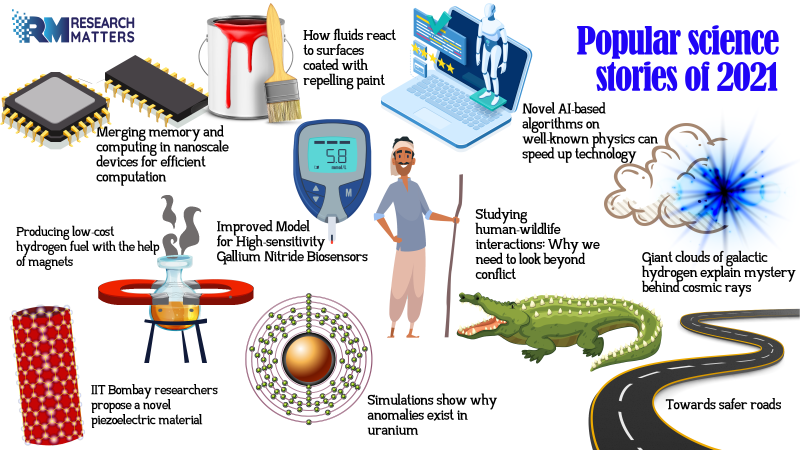
As we wrap up another year, we are glad that you were glued to some of the stories we have published. Articles that showcased advances in engineering, technology, and material sciences ruled your choice this year. In ecology and conservation, a different perspective caught your attention. As always, space and astronomy stories garnered interest. Here, we curate a list of the ten most-viewed articles.
1. IIT Bombay researchers propose a novel piezoelectric material
Piezoelectric materials are fast gaining ground for their various applications ranging from watches to motion sensors to aircraft motion dampers. This article showcases an enhanced piezoelectric material developed by a team from the Indian Institute of Technology Bombay (IIT Bombay). They reinforced a readily available piezo-ceramic material with graphene nanoparticles. The improved material has potential in designing cutting-edge robotic devices and satellite applications and making biomedical devices that require high elastic properties.
2. Producing low-cost hydrogen fuel with the help of magnets
Scientists are actively researching hydrogen gas as an alternate fuel source due to its high energy content and environmentally friendly properties. Unfortunately, hydrogen is sparse in the atmosphere and hence extracting the gas from water is our next best option. However, the extraction process is fraught with many challenges, requiring high power and cost. Read this article to find out how the research team from IIT Bombay devised a low-cost method to extract hydrogen from water.
3. Merging memory and computing in nanoscale devices for efficient computation
An active research area in computers and faster computation speeds is utilising the temporary memory storage (RAM) for both storage and performing logical computations. For this, newer types of devices called Resistive RAMs are being developed. This article will walk you through how an IIT Bombay team 'sneaked in' a nanoscale third terminal into a conventional two-terminal device to enhance its computing performance.
4. Studying human-wildlife interactions: Why we need to look beyond conflict
Human-animal conflicts quickly make it to the news, for they impact our safety. However, interactions where humans strive to co-exist with the animals and vice-versa, are just emerging. Researchers Anirudhkumar Vasava from Voluntary Nature Conservancy, Gujarat, and Simon Pooley from the Birkbeck University of London, UK, have attempted to understand this in a village in Gujarat that shares its neighbourhood peacefully with one of the deadliest crocodiles of India. This engaging article prompts us to change our perception and delve into human-animal coexistence. The researchers say that more studies on coexistence are needed.
India witnesses the highest road crashes globally. However, implementing Advanced Driver Assistance Systems (ADAS) that work on roads abroad fail on Indian roads due to different driving behaviours and infrastructural conditions. A team from IIT Bombay analysed the factors and developed a prediction model for ADAS suited to Indian driving conditions. Read on to see what they found that could make our roads safer.
6. Giant clouds of galactic hydrogen explain the mystery behind cosmic rays
Astronomers are still deciphering the secrets of cosmic rays – charged particles purportedly emanating from faraway dying stars. This story portrays the efforts of scientists from the Raman Research Institute (RRI), who have inched closer to solving the mystery of these highly charged particles hurling in space. The study also unravels why an excess of positrons has been observed in the cosmic rays – a cascading effect resulting from the rays interacting with electrons and positrons of the galactic particles, in turn producing more cosmic rays.
7. Novel AI-based algorithms on well-known physics can speed up technology
Metasurfaces are not-so-useful materials transformed into useful ones by coating their surfaces with suitable nanomaterials. Maxwell equations give insights into how light interacts at these surfaces, and algorithms minimise the labour and computing time of solving these complex equations. This interesting article discusses how IIT Bombay researchers' novel algorithm can quickly analyse the surface interactions of these futuristic materials.
8. Simulations show why anomalies exist in Uranium
Several electronic and thermal aspects of Uranium — the radioactive element that can meet the world's energy requirements— is still not well-understood. For example, Uranium exhibits several ‘Kohn anomalies’ or aberrations in its mathematical description of atomic vibrations, and these have remained unexplained for five decades. Researchers from IIT Bombay and the Bhabha Atomic Research Centre (BARC), Mumbai have used simulations to explain some of Uranium's Kohn anomalies, thus unravelling the mysteries of this important radioactive material.
9. How fluids react to surfaces coated with repelling paint
IIT Bombay researchers experimented on the water flow dynamics of water-repellent paint. The benefits of such paints could be far-reaching: windshields that don't require wipers or reduced fuel consumption due to reduced drag caused during rainy weather conditions. Read on to know more about this exciting research.
10. Improved Model for High-sensitivity Gallium Nitride Biosensors
The newly emerging technology of Gallium Nitride bio-sensors can detect early-onset diseases. Researchers from IIT Bombay used a computational model to tweak the sensitivity of the currently available biosensors. This article discusses how the researchers tweaked the analytical formulation of the sensors. Using this method, the device makers can further improve the device's sensitivity and detect even minute changes in the concentration of the molecules under scrutiny.
We at Research Matters look forward to your continued engagement with us and a fabulous journey ahead. Watch out for more exciting reads!





